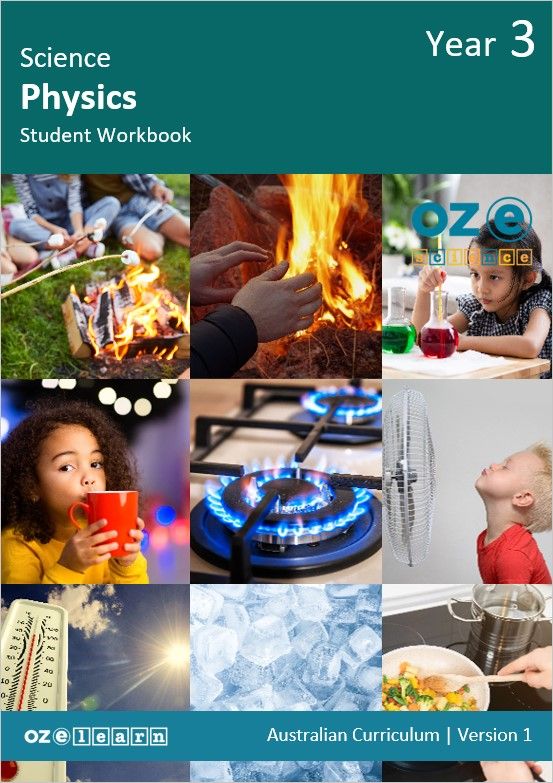Oz-e-science
Physics - Year 3
Write your awesome label here.
Write your awesome label here.

Teaching resources
Overview
Physics Year 3 is the study of what things are made of, how they move and how they get energy. It aligns to the Australian Curriculum Science Understanding:
Note: This curriculum program is currently being updated to align with the Australian Curriculum 9.0. Updated versions will be released in early 2024.
- Sudden geological changes and extreme weather events can affect Earth’s surface (ACSSU096).
Note: This curriculum program is currently being updated to align with the Australian Curriculum 9.0. Updated versions will be released in early 2024.
Learning Objectives
In lessons 1 to 9, students learn about:
- identifying common examples of objects that are hot and explaining how to keep warm
- identifying common examples of objects that are cold, explaining and investigating how objects cool down when heat energy leaves them
- identifying examples of friction producing heat and explaining how the moving energy of rubbing surfaces together
- changes to heat energy. identifying and explaining electric machines that make heat and observing electrical machines producing heat
- identifying some chemicals that can cause a burning chemical reaction and explain that burning is a chemical reaction that changes into heat energy
- explaining conduction is the movement of heat between surfaces that are touching
- observing conduction in different solids
- explaining the use of conduction in Indigenous cooking methods
- describing how Indigenous Australians cook food on coals
- predicting and measuring the temperature of a variety of items
- presenting their findings in a graph.
Success Criteria
- Investigate what we can see in the day and night.
- Explain how to keep warm.
- Identify common examples of objects that are cold.
- Explain how heat energy can move from objects.
- Investigate how to cool something down.
- Identify examples of friction producing heat.
- Explain how the moving energy of rubbing surfaces together,
- changes to heat energy.
- Identify electric machines that make heat.
- Explain how electric machines make heat.
- Observe electrical machines producing heat.
- Identify some chemicals that can cause a burning chemical reaction.
- Explain that burning is a chemical reaction that changes into heat energy.
- Explain that conduction is the movement of heat between surfaces that are touching.
- Identify conduction in different solids.
- Explain how conduction is the transfer of heat in the cooking methods of Indigenous Australians.
- Describe how Indigenous Australians cook food on coals.
- Explain what temperature is.
- Identify how we measure temperature.
- Do an experiment to measure the temperature of a variety of items.
- Presenting your findings to the class.
Assessment
Progress Tests
Progress tests are conducted after every second lesson, allowing teachers to monitor student understanding of the concepts taught over the past two lessons and to identify where reteaching is needed. The Teaching Guide contains the testing questions, and the Student Workbook has a section where students write their answers and score themselves.
Structured Research Activity
The Structured Research Activity (SRA) for this unit is: Students to measure heat using a thermometer and present their findings in a graph. The SRA takes place over two lessons so students can apply the Science Understanding and Science Inquiry Skills covered in the unit. Teachers use the Guide to Making Judgements, which is included in the Teaching Guide, to mark the SRA.
End-of-Unit Assessment
The last lesson is the end-of-unit assessment which has a variety of question formats (e.g. label the diagram, circle the correct answer) to assess student mastery of content from the unit. The end-of-unit assessment is in the Teaching Guide. Teachers copy the assessment and distribute to students at testing time.
Progress tests are conducted after every second lesson, allowing teachers to monitor student understanding of the concepts taught over the past two lessons and to identify where reteaching is needed. The Teaching Guide contains the testing questions, and the Student Workbook has a section where students write their answers and score themselves.
Structured Research Activity
The Structured Research Activity (SRA) for this unit is: Students to measure heat using a thermometer and present their findings in a graph. The SRA takes place over two lessons so students can apply the Science Understanding and Science Inquiry Skills covered in the unit. Teachers use the Guide to Making Judgements, which is included in the Teaching Guide, to mark the SRA.
End-of-Unit Assessment
The last lesson is the end-of-unit assessment which has a variety of question formats (e.g. label the diagram, circle the correct answer) to assess student mastery of content from the unit. The end-of-unit assessment is in the Teaching Guide. Teachers copy the assessment and distribute to students at testing time.
Recommended Units
Baninh Yeeum Building 302-310 Sheridan Street, Cairns QLD 4870
PO BOX 278, North Cairns QLD 4870
Phone: 1800 00 GGSA (4472)
info@goodtogreatschools.org.au
Empty space, drag to resize
Subscribe to our newsletter
Thank you!
Empty space, drag to resize
2023 All Rights Reserved
Write your awesome label here.
Write your awesome label here.
Write your awesome label here.
Subscribe to our newsletter now!
Get weekly updates on live streams, news and more right in your mailbox.
Thank you!
Write your awesome label here.
Write your awesome label here.
Planned 24 Hour Maintenance
Website Temporary Unavailable
10AM 05 January until 10AM 06 January 2024
Dear school teams
You will not be able to access your content during this time. We will be busy loading all the new enhancements you asked for. We are confident you will be delighted with the new features we have designed for you! Please join on Saturday after 10:00am to try them out!
School Partnerships Team

